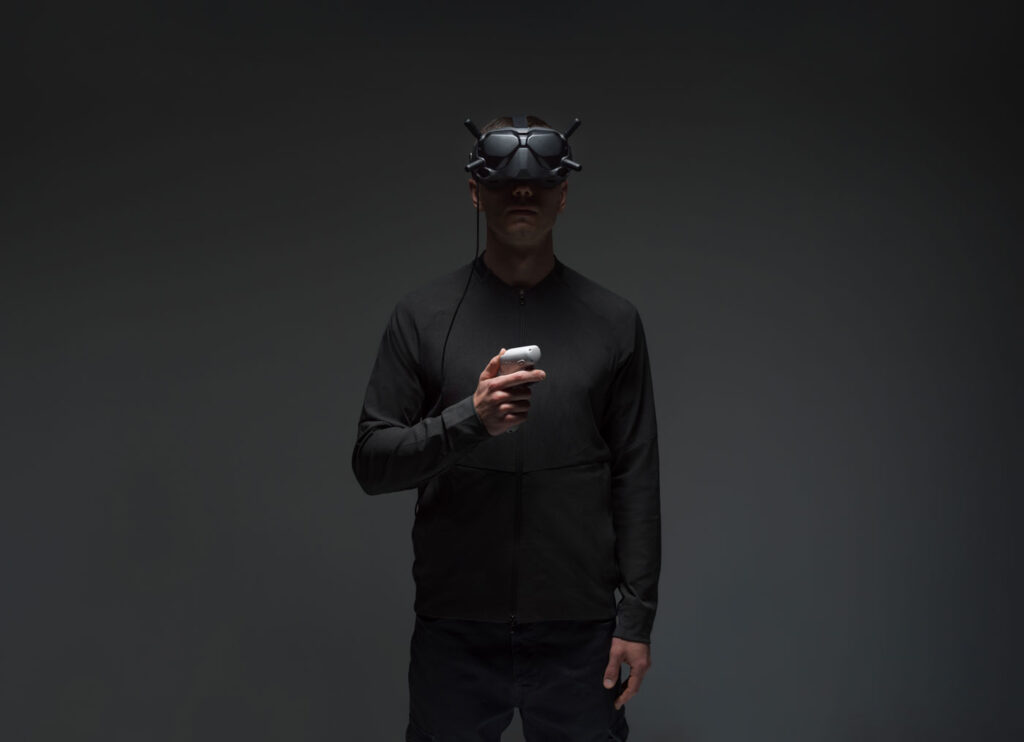For its 15th anniversary, DJI sees things big. The n ° 1 consumer drones, visibly in great shape, unveils the DJI FPV. This new model aims to democratize the flight with the drone in the first person and must offer a reinvented experience of flight thanks to a helmet intended for this purpose. This new DJI product also offers impressive performance, with a maximum speed of 140 km / h. Here is a look back at all the characteristics of this drone-like no other.
DJI’s First FPV Drone | The Best Drone In The World
After having largely contributed to democratizing the practice of the drone, DJI is now tackling drones piloted in the 1st person (FPV, for First Person View ). Very fashionable, FPV relies on the use of a dedicated headset. The result is a real immersion in the heart of the scene, and the feeling of being at the controls of an Alpha Jet plane. This technology is particularly widespread in the world of racing drones, called racers.
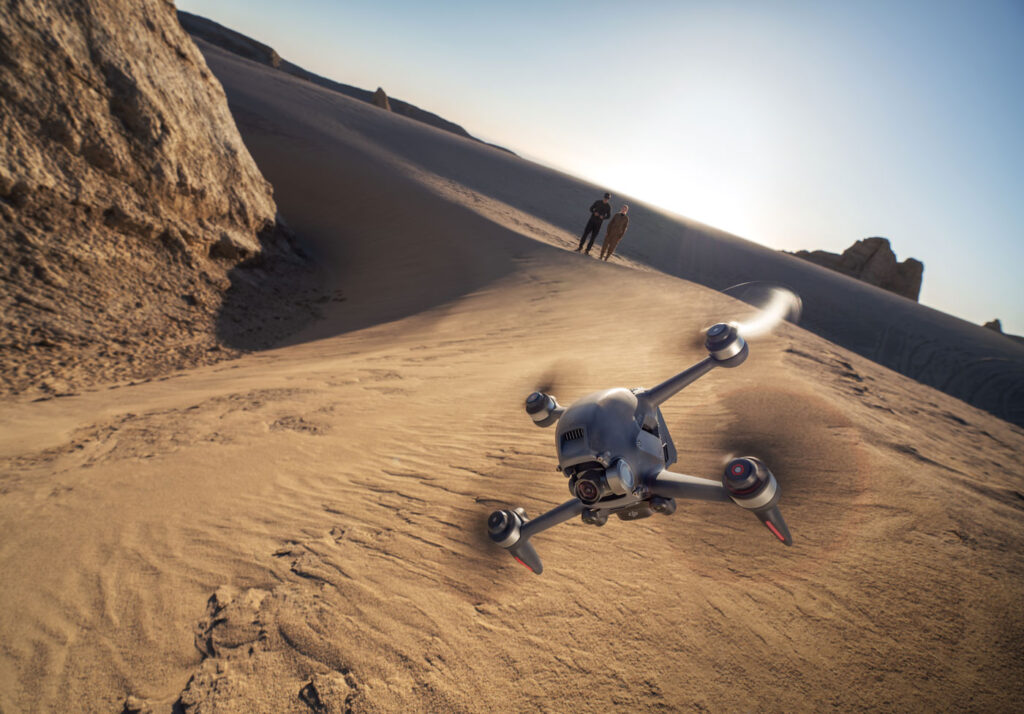
Also, the new DJI FPV aims to embody the perfect fusion between a drone racer – for its velocity, its agility, and the impressive images it allows to capture – and the image quality offered by a “classic” drone.
In fact, this new drone adopts a design radically different from other DJI models. Intended to move forward – like the Parrot Disco flying wing – the drone is fully tilted forward, at an angle of around 45 °. It thus seems resolutely designed for speed, to allow you to obtain impressive images.

Here are the detailed specifications of the DJI FPV:
- Folding arms: No
- Weight: 795 grams
- Drone dimensions : 255 x 312 x 127 mm (with propellers)
- Diagonal: 245 mm
- The maximum rate of climb :
- Manual mode: no limit
- Sport mode: 10 m / s
- Normal mode: 8 m / s
- Maximum speed : 140 km / h
- Manual mode: 39 m / s (140 km / h)
- Sport mode: 27 m / s (97 km / h)
- Normal mode: 15 m / s (54 km / h)
- Max acceleration : 0-100 km / h: 2 sec
- Sensor : 1 / 2.3 inch, 12 Mpx
- Video resolution: 4K UHD 60/50 fps, Full HD 120/100/60/50 fps
- Maximum photo size : 3840 x 2160 pixels
- Photo format: JPEG only
- Focal length (24 × 36 equivalent): 14.66 mm
- Aperture : f / 2.8
- Platform tilt : height only (-50 ° – 58 °)
- Battery: 2000 mAh
- Maximum flight time: 20 minutes (measured in flight at 40 km / h in windless conditions)
- Operating temperature: -10 ° C to 40 ° C
- Maximum range: 6 km
- Obstacle detection: front (in N mode only), down (dual optical sensor)
- Positioning: GPS, Glonass, Galileo
Speed as the main objective
Maximum speed: 140 km / h. 0-100 km / h: just 2 seconds . The DJI FPV displays particularly impressive values and should provide an undeniable sensation of speed.

There are, three flight modes are available:
- Normal mode, which offers controls similar to other DJI drones. The aircraft stabilized while awaiting the pilot’s instructions;
- Manual mode, which offers full manual control and unlocks the maximum performance of the device; this mode is deactivated by default and reserved for experienced pilots because no piloting aid is available;
- Sport mode, a sort of combination between N and M modes, which allows for assisted piloting while offering a maximum speed of around 100 km / h and better handling than Normal mode. In this mode, the drone is also stabilized.

For more safety, the DJI FPV is equipped with 2 obstacle sensors located under the drone, and 2 sensors placed at the front. It is also equipped with an infrared sensor, allowing the device to operate indoors. As the aircraft is primarily intended to fly forward, it skips the obstacle detection sensors on the sides or rear.

Notably, the obstacle sensors located at the front are deactivated in Sport and Manual mode, allowing seasoned pilots to fly very close to the ground without the aircraft, for more impressive images. Normal mode is more secure: the obstacle sensors are activated and speeds are reduced, minimizing the risk of a crash.

Finally, an emergency braking function is available from the remote control. When you activate it, the drone stops (almost) instantly and hovers in place. However, the manufacturer indicates that a minimum distance of 30 meters is necessary for the drone to stop, normal given its maximum speed.

Of course, the “Return to home” function is also present, allowing you to easily bring the device back to hand. Finally, the device incorporates an ADS-B receiver. The latter detects nearby flying machines and sends you a notification to react accordingly.
12 MP sensor and 4K 60 fps video
To capture photos and videos, the DJI FPV is equipped with a 1 / 2.3 inch (measuring 6.17 x 4.55mm) 12MP sensor. It is surmounted by a 14.66 mm equivalent wide-angle lens opening at f / 2.8. The ISO range is from 100 to 12,800 ISO; the shutter speed, meanwhile, ranges from 1/50 to 1/8000 s. Images can only be captured in JPEG.
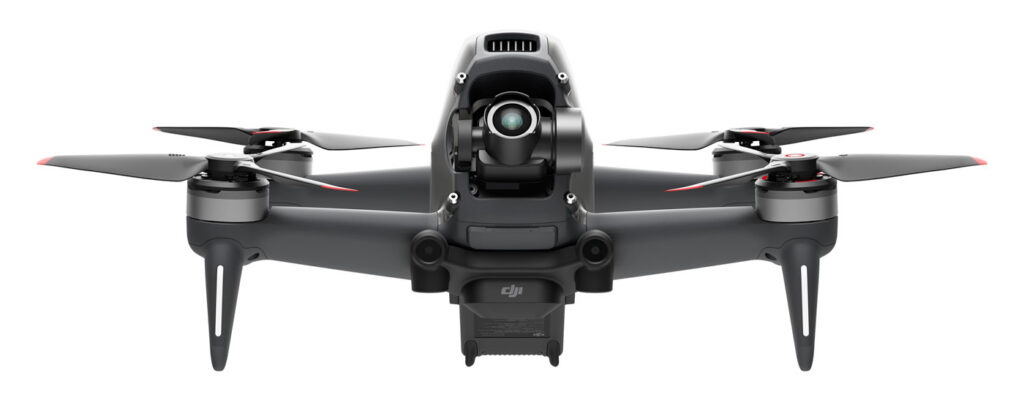
Resolutely designed for video, the DJI FPV is capable of filming in 4K at 50 or 60 fps, with a maximum speed of 120 Mbits / s. In Full HD, it has a slow-motion mode at 100 or 120 fps. Images can be saved in H.264 or H.265 for more efficient compression. The device also offers a D-Cinelike color profile. The result is a greater range of image adjustments in post-production.
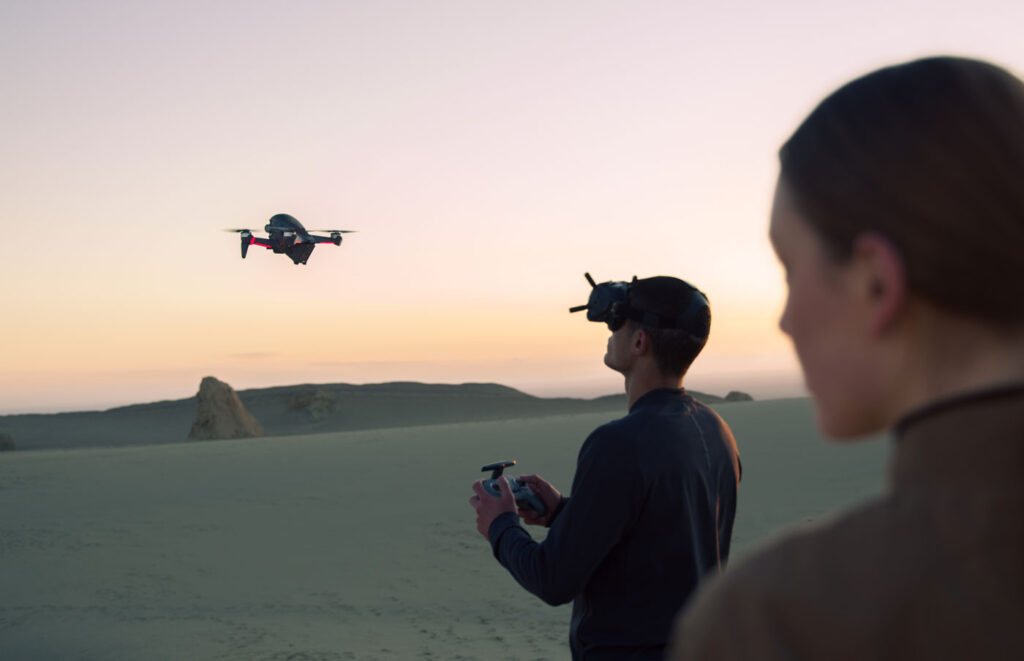
For greater video stability, the DJI FPV uses an Electronic Stabilization System (EIS) called RockSteady. Already present on the DJI Osmo Action camera, it must erase any possible tremors from the device. It should also make it possible to smooth the acceleration/braking and sudden movements of the drone. Finally, note that the camera gimbal can only be tilted in height (from -50 ° to 58 °).
DJI FPV V2 Headset
To follow the evolutions of the drone live, DJI relies on the DJI FPV V2 headset, the second version of its immersion headset.
The latter communicates with the drone thanks to the OcySync 3 system, which must offer extremely low latency (only 28 ms). In addition, the drone and the helmet support the frequency bands of 2.4 and 5.8 GHz and are able to switch automatically from one to the other. The result is better image quality and better signal reliability.
The interest of these headphones: immerse you in the heart of the scene, and offer a feeling of speed impossible to obtain by looking only at the screen of a smartphone. The helmet also allows more precise piloting – essential for making your drone evolve at high speed.
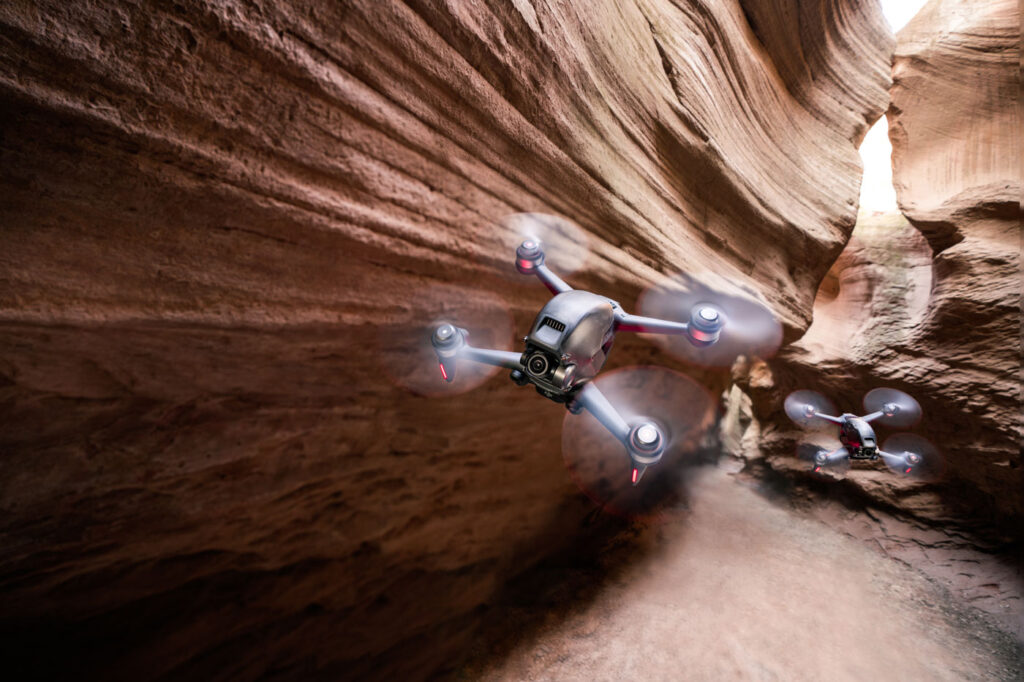
Beyond the video feedback, the headset displays various information: the battery level of the headset and the drone, obstacle detection, altitude, distance from the starting point, flight mode, etc. A “5D” button provides access to the settings, but also to browse the different images captured by the drone.
Finally, a Public mode allows the use of several DJI FPV V2 headsets. You will be able to share the video feedback of your drone with other people.
However, the DJI FPV 2 headphones are quite imposing. Weighing around 420 g (with headband and antennas), it measures 202 x 126 x 110 mm. In addition, it has 4 small antennas to receive the video signal. The maximum range of the helmet is 10 km maximum; however, this is restricted to 6 km for the European version.

The helmet has ergonomic foams for greater comfort. Inside, there are two small 2-inch screens – with a definition of 1440 x 810 px. They have a refresh rate of 144 Hz for greater visual comfort. A small slider allows you to adjust the spacing of the 2 screens (interpupillary spacing) between 58 and 70 mm. The maximum field of view is 150 °. Finally, the headset is able to handle a flow of images at 120 fps.
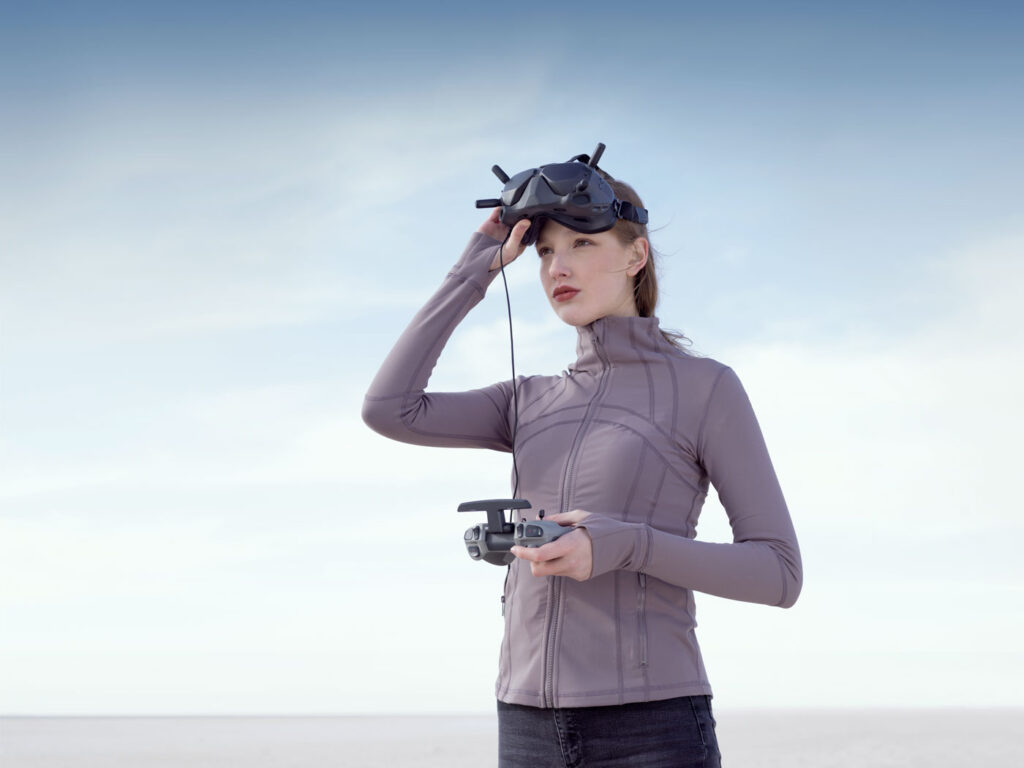
The first version of the DJI FPV headset (launched in 2019) already offered very good image quality, with excellent reproduction of details, colors, and contrasts. No doubt this second version should do at least as well. Note that the headset is equipped with a micro SD card slot (up to 256 GB), and is capable of recording photos and videos (H.264 codec only).
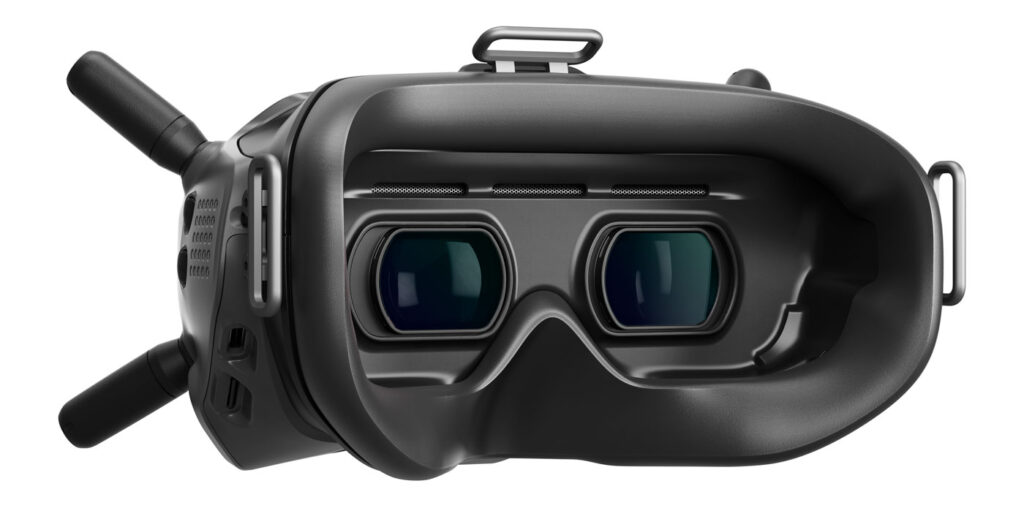
Finally, the headset has an 1800 mAh battery and must be able to operate for 1 hour and 50 minutes maximum according to DJI.
Remote control and new motion controller
To control the evolutions of the drone, DJI provides a “standard” remote control. The latter is in every way similar to that which accompanies the drones of the Phantom range. Rather massive, it has no screen, the drone only works with the helmet. Its battery should offer it an autonomy of about 9 hours.

However, the DJI FPV can also be controlled with a new accessory, which DJI calls “Motion Controller”. The latter comes in the form of a small joystick, which is not unlike those on fighter jets (or at least the ones you used to play a simulation game in the 2000s).
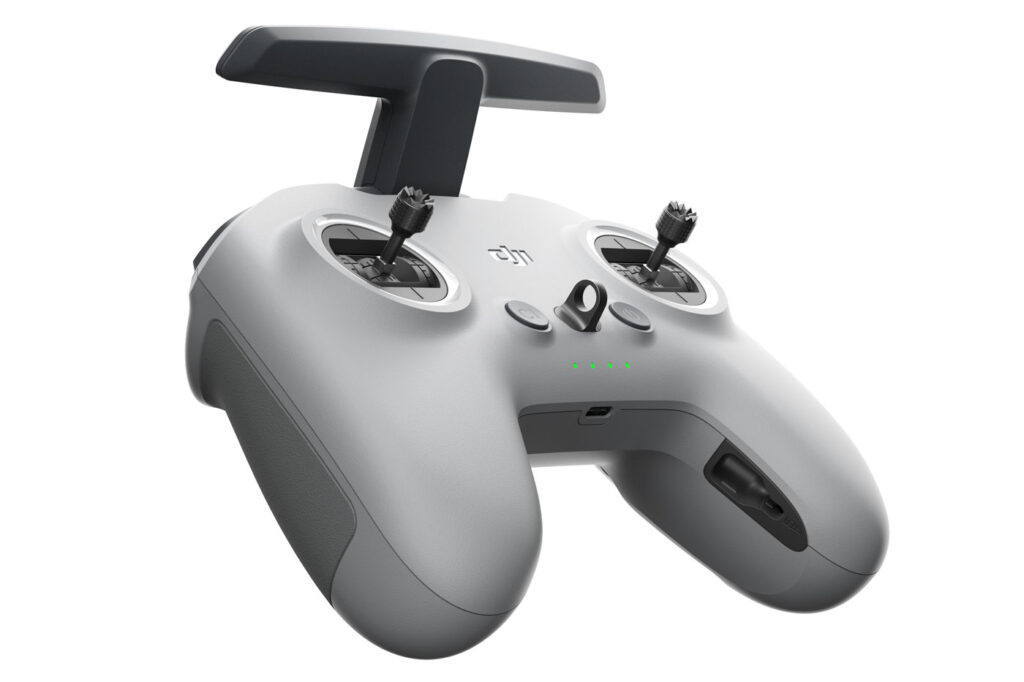
Very light (167 g), it fits in the palm of the hand. It is equipped with a gyroscope. So, you just need to tilt it in the direction you want, and the device should respond with your finger and eye (no pun intended). A trigger also controls acceleration. Finally, a pad allows you to direct the orientation of the camera. This accessory should thus make the flight even more intuitive, and present a certain interest. It is available as an option.
DJI Fly App
To accompany its drone, DJI once again calls on DJI Fly, its “simplified” application. It offers the ability to easily read and edit video rushes, before sharing them on social networks.
A Fly Spots feature also makes it possible to locate interesting places for the practice of the drone; however, the latter is only available in China. Finally, a feature will soon make it possible to display the live view of the headset on the smartphone, when it is connected by cable. This function will be available thanks to a future firmware update.
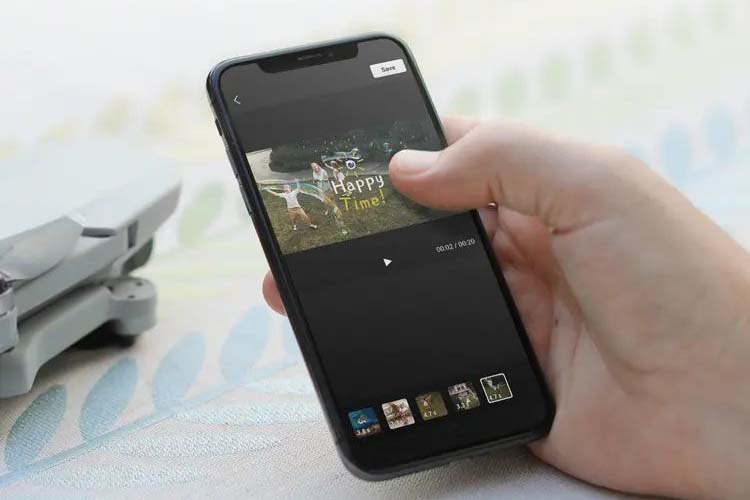
A new app, named DJI Virtual Flight App, is also available. It features a series of tutorials and a real flight simulator to get you familiar with FPV flights. However, this application is only offered for iOS (from version 11), and DJI has not yet mentioned a version for Android.
An easy-to-repair drone?
As the practice of first-person flight is not without risk, DJI has made it easier to replace parts damaged in a crash. Thus, the camera nacelle, the landing gear, and the upper shell of the device are modular and must be easily replaced.
Of course, the Chinese manufacturer offers its DJI Care Refresh warranty, which should minimize the cost of repairs.
Price and availability of the DJI FPV drone
The DJI FPV drone will be offered only Combo Pack, including the DJI FPV drone, the V2 DJI FPV virtual reality headset, and the DJI FPV remote control. Count 1349 € for the whole, available on the DJI site as well as at Digit-Photo or Studio Sport in particular.
A “Fly More” pack is also available for € 1,628. The latter includes a total of 3 batteries, as well as a charging hub.
The motion controller, meanwhile, is available at a price of 149 €.

Our first opinion on the DJI FPV
DJI’s bet is daring. With this new kind of drone, the Chinese brand is rushing into a niche market and aims to appeal to remote pilots who love thrills and very dynamic images. In doing so, the manufacturer is investing in a very specific area, until now reserved for experienced pilots, who build their own machines before sending them into the air. Thus, the brand is creating a new marketing segment: that of the “general public” FPV drone. A strategy that it had already deployed with “classic” drones – with the success that we know.
However, the DJI FPV faces a major obstacle: that of regulation. Indeed, the latter turns out to be even more restrictive than for the “classic” practice of the drone. According to the texts in force in France, you must imperatively be accompanied by a second person, who will have to monitor the evolutions of the drone. Likewise, the device must remain within sight, which singularly limits its field of action. Finally, the question of European regulations arises, the device being without a CE class marking.
Even so, the DJI FPV is undoubtedly one of the most attractive drones the brand has launched. It radically changes the practice of the drone. Thanks to its dedicated headset, it allows you to be fully immersed in the scene you are capturing. And its new motion controller offers a new way to control it, both more intuitive and more dynamic.
However, a fairly high price remains, but which is justified by the technological arsenal deployed by the Chinese brand.










